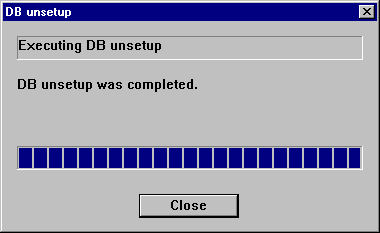This section describes the actions to take if there is insufficient free space in a repository used by a Management Server.
Perform this procedure on a Management Server.
Point
You can use this troubleshooting method when there is insufficient free space in a repository, or if the operation status is significantly different from the status at the initial installation, in order to ensure that there is sufficient free space in the repository in the future.
Increase the amount of repository space as follows:
Back up the registry of a Management Server (refer to "11.1.1.5.1 Backing up a registry")
Perform stored data backup processing (refer to "11.2.1.1 Database backup")
Perform database unsetup (refer to "11.2.1.4 Database configuration removal")
Re-estimate the database size (refer to "Estimation of database size" in the ETERNUS SF Installation and Setup Guide)
Perform database setup (refer to "11.2.1.3 Database configuration")
Start the services "SymfoWARE RDA RDBSWSTF" and "SymfoWARE RDB RDBSWSTF" (refer to "Chapter 2 Starting and Stopping Services")
Point
It is not necessary to start the "SymfoWARE RDA RDBSWSTF" service if this is running under Windows Server 2008 or later.
Perform saved data restoration processing (refer to "11.2.1.2 Database restoration")
Perform restoration of the registry of a Management Server (refer to "11.1.1.5.2 Restoring a registry")
This section describes the backing up of a database. You can save data stored in a database to the specified directory. This method is mainly used for copying data for reuse for other purposes. For ordinary backup purposes, use the method described in "11.1.1.4.1 Saving a database".
Note
A directory in which data will be saved must be created in advance.
Executing this process with the service listed below must be paid attention.
Terminal service (via a remote desktop connection)
If the Management Server is running on Windows Server 2003, the Terminal Service must be used by making a console session connection to it. Refer to the following link for information on how to make console session connections:
http://support.microsoft.com/kb/947723/en
http://support.microsoft.com/kb/278845/en
Do not use service listed below, as it will not work properly.
Telnet server service
Back up a database as follows:
Click the Start button and select [Programs] -> [AdvancedCopy Manager] -> [DB setup].
The following DB setup initial window will be displayed. Click the [DB maintenance] button.

The following DB maintenance window will be displayed. Click the [DB backup] button.
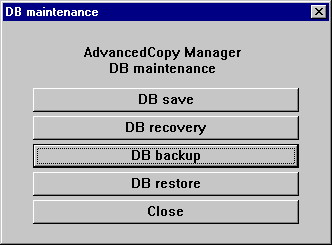
The following window for entering a backup directory will be displayed. Enter a backup directory and click the [OK] button.
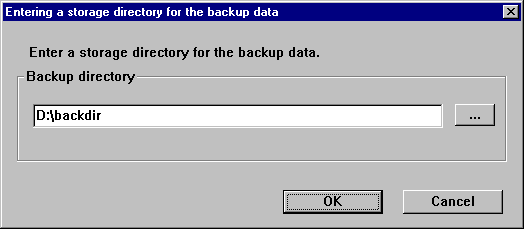
Note
Create the backup directory in advance.
The blank space and the following characters [" | : * ? / . < > , % & ^ = ! ; # ' @] cannot be used in the backup directory name.
The following window will be displayed. Check that the displayed information is correct and click the [Start] button.

When the backup is completed, the following window will be displayed. Click [Close].

This section describes the restoration of a database. You can restore data that has been saved as described in "11.2.1.1 Database backup" to a database as shown below.
Note
Data currently stored in a database will be lost in this processing because it will be overwritten by saved data.
When the database restoration has completed normally, the database should then be backed up to save this copy of the data. For more information on this, refer to "11.1.1.4.1 Saving a database".
Executing this process with the service listed below must be paid attention.
Terminal service (via a remote desktop connection)
If the Management Server is running on Windows Server 2003, the Terminal Service must be used by making a console session connection to it. Refer to the following link for information on how to make console session connections:
http://support.microsoft.com/kb/947723/en
http://support.microsoft.com/kb/278845/en
Do not use service listed below, as it will not work properly.
Telnet server service
Restore a database as follows:
Click the Start button and select [Programs] -> [AdvancedCopy Manager] -> [DB Setup].
The following DB setup initial window will be displayed. Click the [DB maintenance] button.

The following DB maintenance window will be displayed. Click the [DB restore] button.
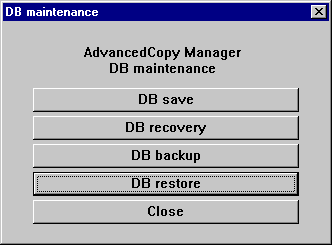
The following window for specifying a backup data storage directory will be displayed. Specify a directory in which backup data has been stored and click the [OK] button.

The following window will be displayed. Check that the displayed information is correct and click the [Start] button.
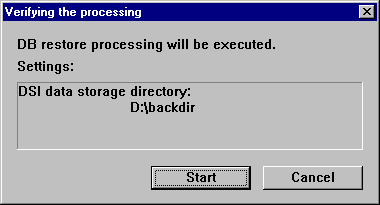
When the restoration is completed, the following completion window will be displayed. Click [Close].
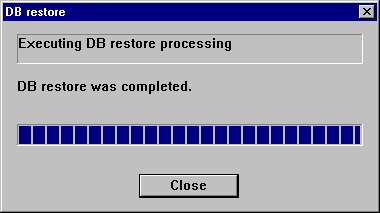
This section describes how to configure a database.
Point
Please record the logon user who set the database information.
This logon user is needed for the unsetup the database information.
The unsetup the database information may be failed, when the unsetup is executed by a user different from the user who executed the setup.
Note
Executing this process with the service listed below must be paid attention.
Terminal service (via a remote desktop connection)
If the Management Server is running on Windows Server 2003, the Terminal Service must be used by making a console session connection to it. Refer to the following link for information on how to make console session connections:
http://support.microsoft.com/kb/947723/en
http://support.microsoft.com/kb/278845/en
Do not use service listed below, as it will not work properly.
Telnet server service
Configure a database as follows:
Click the Start button and select [Programs] -> [AdvancedCopy Manager] -> [DB Setup].
The following window will be displayed. Click the [DB setup] button.
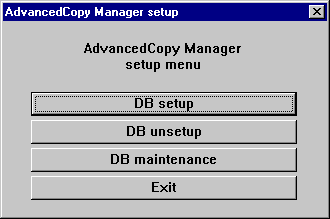
The following window will be displayed. Enter the necessary items and click the [Continue] button.
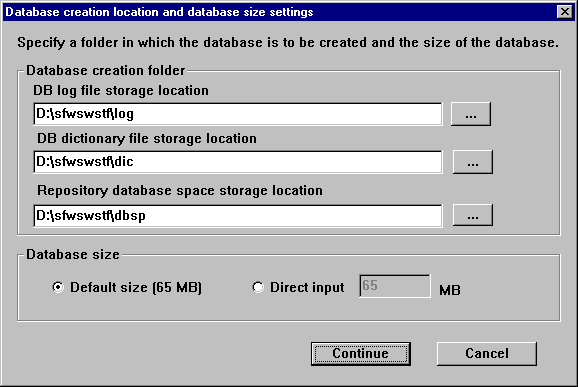
Note
The number of characters in a folder name must be between 4 and 80. The blank space and the following characters [" | : * ? / . < > , % & ^ = ! ; # ' @] cannot be used in folder names.
Do not check the option [Compress drive to save disk space] in the General tab for any of these drives.
If the drive is compressed, performance overhead is generated compared to a non-compressed drive, and depending on the I/O amount access error may occur in low OS resources conditions.
Do not check the [Compress or Encrypt Attributes] in the [Advanced Attributes] section of the [Properties] or [Advanced] part of the General tab.
If the compression property is checked, as with the drive compression performance overhead is generated compared to normal I/O and access error may occur in low OS resources conditions.
If the encryption property is checked access error may occur when decryption cannot be performed.
The following window will be displayed. Enter the necessary items and click the [Settings] button.
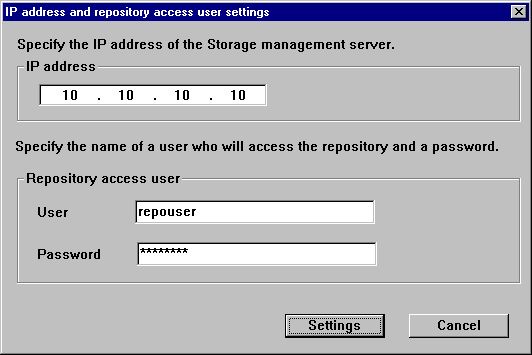
The following conditions apply to the user name and password:
They must be specifiable under the operating system.
Their length must be 18 bytes or less.
In addition, specify the user shown in the table below according to each server type to be used for the user name.
Server type | ||
|---|---|---|
Domain controller | Machine belonging to a domain | WORKGROUP |
Domain user | Local user | Local user |
The following window will be displayed. Check the displayed information and click the [Start] button.
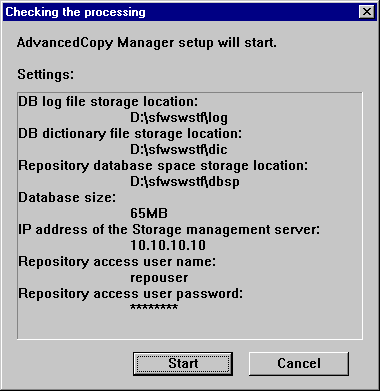
When the database setup is completed, the following window will be displayed. Click the [Close] button.
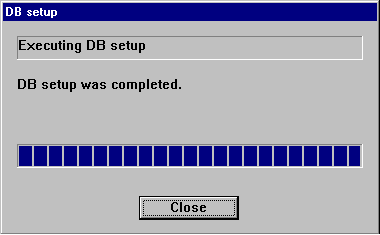
Remove the setup of a database as follows:
Point
Remove the setup of a database by a user who executed its setup.
The remove may be failed, when it executed by a different user.
Note
Executing this process with the service listed below must be paid attention.
Terminal service (via a remote desktop connection)
If the Management Server is running on Windows Server 2003, the Terminal Service must be used by making a console session connection to it. Refer to the following link for information on how to make console session connections:
http://support.microsoft.com/kb/947723/en
http://support.microsoft.com/kb/278845/en
Do not use service listed below, as it will not work properly.
Telnet server service
Remove a database as follows:
Click the Start button and select [Programs] -> [AdvancedCopy Manager] -> [DB setup].
The following DB setup initial window will be displayed. Click the [DB unsetup] button.
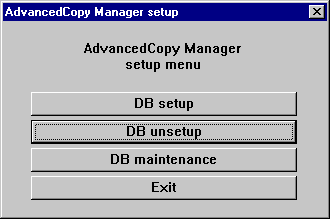
The following confirmation window will be displayed. Click the [Start] button.

When the removal of the setup is completed, the following completion window will be displayed. Click [Close].
